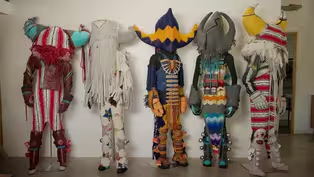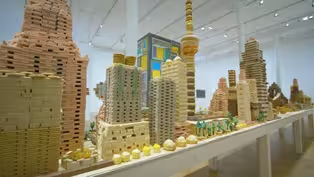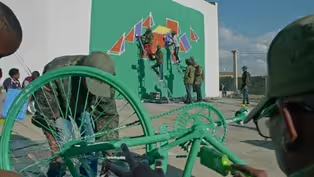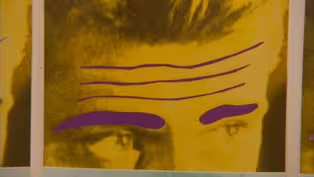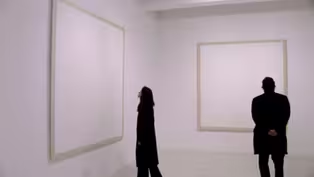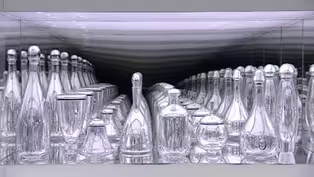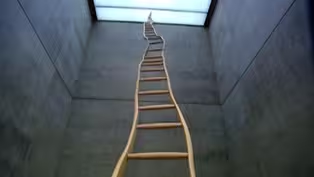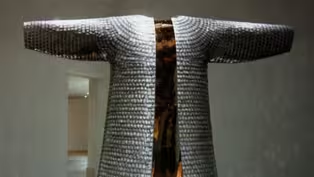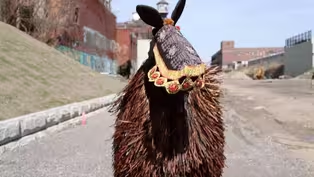
Chicago
Season 8 Episode 1 | 55m 16sVideo has Closed Captions
Featuring artists Nick Cave, Theaster Gates, Barbara Kasten, and Chris Ware.
How does the city of Chicago inspire the artists who live there? How is the architecture, history, and character of the city interpreted and reflected in the work of Chicago-based artists? Which parts of the city are most moving and motivational? In this episode, artists reveal the ways in which their communities ignite ideas for photographs, sculptures, and drawings, and how those communities are
Problems playing video? | Closed Captioning Feedback
Problems playing video? | Closed Captioning Feedback

Chicago
Season 8 Episode 1 | 55m 16sVideo has Closed Captions
How does the city of Chicago inspire the artists who live there? How is the architecture, history, and character of the city interpreted and reflected in the work of Chicago-based artists? Which parts of the city are most moving and motivational? In this episode, artists reveal the ways in which their communities ignite ideas for photographs, sculptures, and drawings, and how those communities are
Problems playing video? | Closed Captioning Feedback
How to Watch ART21
ART21 is available to stream on pbs.org and the free PBS App, available on iPhone, Apple TV, Android TV, Android smartphones, Amazon Fire TV, Amazon Fire Tablet, Roku, Samsung Smart TV, and Vizio.
Buy Now
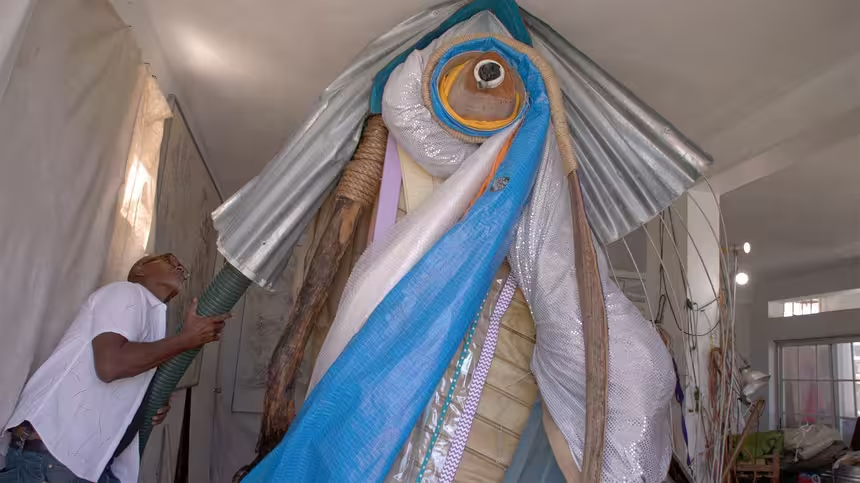
Everyday Icons
Learn more about the artists featured in "Everyday Icons," see discussion questions, a glossary, and more.Providing Support for PBS.org
Learn Moreabout PBS online sponsorshipMore from This Collection
Video has Closed Captions
Artists look to friends, family and strangers to find emotional connection and community. (55m 11s)
Video has Closed Captions
Featuring artists Guan Xiao, Liu Xiaodong, Song Dong, Xu Bing, and Yin Xiuzhen. (55m 1s)
Video has Closed Captions
Featuring artists David Goldblatt, Nicholas Hlobo, Zanele Muholi, and Robin Rhode. (55m 4s)
Video has Closed Captions
Featuring artists Thomas Hirschhorn, Leonardo Drew, and Graciela Iturbide. (54m 35s)
Video has Closed Captions
Featuring artists Catherine Opie, El Anatsui, and Ai Weiwei. (54m 54s)
Video has Closed Captions
Featuring artists Julie Mehretu, John Baldessari, Kimsooja, and Allan McCollum. (54m 11s)
Video has Closed Captions
Featuring artists Mark Bradford, Catherine Sullivan, Robert Ryman, Allora & Calzadilla. (54m 25s)
Video has Closed Captions
Featuring artists Susan Rothenberg, Mike Kelley, Hiroshi Sugimoto, and Josiah McElheny. (54m 10s)
Video has Closed Captions
Featuring artists Martin Puryear, Paul Pfeiffer, Vija Celmins, and Tim Hawkinson. (53m 40s)
Video has Closed Captions
Featuring artists Kara Walker, Kiki Smith, Do-Ho Suh, and Trenton Doyle Hancock. (53m 44s)
Video has Closed Captions
Featuring artists Ann Hamilton, John Feodorov, Shahzia Sikander, and James Turrell. (53m 40s)
Providing Support for PBS.org
Learn Moreabout PBS online sponsorship94) Hi.
I'm Claire Danes.
Welcome to the ART21 series "Art in the 21st Century."
ART21 travels the globe to present some of the most innovative artists of our time.
In this episode, we go to Chicago where Nick Cave, Chris Ware, Barbara Kasten, and Theaster Gates start with humble materials as they make epic works that blur boundaries between traditional fine arts and fashion, comics, and design.
Here is "Art in the 21st Century."
Nick Cave: In Chicago, I can try some amazing things.
Chris Ware: It's a great place to be an artist.
There's an honesty to it.
Barbara Kasten: Chicago is a city of architecture.
It was very inspiring to me.
Theaster Gates: Can art and culture change communities?
It does it all the time.
94) Cave: This place of dreaming within my work really is the place that I find that I exist in most of the time.
You know, it's just this sort of amazing state of mind.
It is about dreaming for the audience, but I've got to be able to set up those parameters.
What do I need to sort of put in place to allow you to dream?
I'm based in Chicago.
For me, it's an amazing place to be because I can focus, I can have the type of studio that I need, I can introduce a new project here.
And there is a network of people that I know here that can help sort of inform and build my work.
So it really becomes this interesting sort of laboratory for me.
[spectators oohing] Cave, voice-over: The first Soundsuit was in '92 in response to the Rodney King incident, the L.A. riots.
I was sitting in the park one day and just sort of thinking about, What does it feel like to be discarded, dismissed, profiled?
There was this twig on the ground.
And I looked at that twig as something discarded.
And then I proceeded to just start collecting the twigs in the park.
And I brought them all back to the studio.
And then I started to build this sculpture.
[indistinct conversations] I started to realize that the moment I started to move in it, it made sound.
Then it just literally put everything in perspective.
I was building this suit of armor, something that I could shield myself from the world and society.
And so out of that came this sculpture-performative kind of work.
I think after the first Soundsuit, I had a different approach to art making.
And I realized that I was an artist with a conscience.
The moment I did was the moment that my life literally turned upside-down.
I think it's just me kind of experimenting.
It's like, you know, a scientist exploring alternative ideas.
Cave: How's it look?
Man: Awesome.
Oh, my God.
It looks amazing.
Cave, voice-over: I wanted to be not necessarily something that is defined.
You know, like with the Soundsuit, I don't draw any of them.
If that's areas that are, like, bad, like, put a yellow pin.
OK. Cave, voice-over: I work hard, but I'm one single individual.
It was just too much.
And so I had to hire 3 full-time assistants.
Now there's, you know, 10 studio assistants that are regular full-time assistants.
They're all artists, which is great.
Assistant: I got just the end left.
So just, you know, maybe 2 1/2 square feet.
So that's about 2 days.
Should be done, you know, Thursday, I think.
Cave, voice-over: If I'm coming up with a new concept for a Soundsuit, I tend to always do the first one myself.
It's very meditative for me.
I can do it for hours on end.
I just need a little bit more.
Cave, voice-over: It's all really based on one object that becomes the instigator.
That's how a Soundsuit is built.
It's built on me sort of identifying an object and then me taking that object and relocating it on and around the body.
And then that begins this sort of journey.
[woman singing on radio] We need metal flowers.
A lot of metal flowers.
Cave, voice-over: We just did a road trip looking for materials for the body of work that I'm working on currently.
Cave: Let's go back here.
Look at all this silver.
I need to start collecting that.
Cave, voice-over: I find that when it comes to looking for supplies for my work, I'm at the flea markets, the antique malls looking for something that may spark a new direction.
There's a lot of ducks.
No ducks.
No ducks.
I don't have a list ever.
I may not know how I'm going to use it right at the moment.
But it all eventually sort of comes back around and enters the work at some point.
I'm finding that I'm building work as we're antiquing right on the spot.
I may build an entire piece because I will find "x" here.
And then I'll say, OK, I need to find this to go with "x."
All of this kind of stuff is nostalgic.
It is this place that we want to sort of remember.
One day I just started buying these ceramic birds.
But, you know, I bought them because in my upbringing, that was what was considered precious art.
You know, it was kept in the china cabinet.
And that was my way of staying connected to my grandparents as they were getting older.
And it was my way of honoring and sort of celebrating how they influenced my upbringing and my life.
So a part of the work is really about this sense of honor in the celebratory kind of way that the Soundsuits are fantastic, fantastical.
I'm very much interested in being able to create these concepts that I can immerse myself in.
Cranbrook Art Museum really became the core of this immersive experience.
From that core were these satellite experiences that were built around performance activity.
Choreographer: ...as you're doing this, don't forget, more trotting, more personality, more character.
Yeah!
More energy, more energy, more energy.
There can never be enough energy... Cave, voice-over: One of the performances at Cranbrook was really working with the Detroit School of Arts, which is a public high school.
I think dance has always been a real critical part of my practice.
[indistinct PA announcements] Cave, voice-over: The Soundsuits are really broken up into 2 bodies of work.
One is sculpture work.
Uh, and that's sort of the static work that, you know, you see in the museums.
And then there's this sort of performance, uh, Soundsuits.
[drum music] When producing a project of that scale all of these components and parts and elements they're allit's like building a collage.
I think by the end of the project, probably over 500 people were involved in some aspect of the performance.
That's what we were interested in making happen in Detroit.
How do we get people out of their communities and engaged with the arts?
[applause] "Trayvon Martin" is a new work that was shown at Cranbrook.
It's made up of a black mannequin dressed in a hoodie and sneakers and jeans.
And then surrounding its body is these plastic blow molds.
Which are, like, sometimes at Halloween, there are these plastic forms that are set out in yards.
And so they are surrounding this sort of figure almost as guardians.
But then over top of the entire structure is this web that's constructed out of pony beads.
So from a distance, it looks like this amazing sort of gold sculptural form until you get up close and you realize that there is someone trapped inside.
It's very, very disturbing what's going on right now politically within the black community, not only Chicago but around the country what's going on with police brutality and these unarmed black men that are being killed.
I mean, it just goes on and on.
You know, I think at the end of the day, it's me giving back to the community and being this sort of change agent.
I want to change our way of engaging with one another.
I want to use art as a form of diplomacy.
That's why I'm in this state of urgency right now.
And I don't know.
I just feel so unsettled.
I'm doing what I'm doing, but I'm not sure if it's happening fast enough.
Chris Ware: Look, more trash sculptures.
They look pretty nice, actually.
Girl: Yeah... Ware, voice-over: My day is entirely predicated on the schedule of the Oak Park school system.
In the morning, II get up fairly early before my wife and daughter and sit and write in my diary for a little while and then make breakfast for my daughter.
And then my daughter and I ride the bike to school.
And then I come back and I work between the hours of 8:00 and about 2:45 or so, and then I have to go pick up mymy daughter from school, so...
I used to work all day and all night long in my 20s or so, but, uh, as I've gotten older and as aas a daddy, I just can't do that.
Being called an artist is certainly extremely flattering.
And it's not anything I necessarily ever expected.
There's something about being a cartoonist that seems like an inherently humble sort of activity that I kind of like.
It's just me sitting at a table, and I do what I do.
So, I mean, I guess that's one possible route to making what might be called art.
I was kind of, you know, not the most athletic or popular kid.
So I started drawing comics, I think, because it was a way of both defining myself amongst my peers and also a way of disappearing into myself and me sort of protecting myself from them, so, um, and avoiding, uh, physical...[laughs] combat oror whatever.
That's really the only thing I've ever been able to do, is kind of draw.
It seemed to me like a miraculous sort of ability.
I start every page generally on a piece of, uh, board that's sort of approximately about, uh, 2-by-3 feet or so.
I draw everything in non-photo blue pencil, try to find where the figures are in space in the blue.
And then when that is done, I go over those particular emphasized lines in black ink.
And when this page is photographed, the blue pencil will not appear at all.
It will drop away.
And all that's left will be the black line.
From there, I add in a layer of colors.
Generally each page takes around 40 hours, strangely enough.
It's not like I chose 40 hours because it's the workweek or something.
But it reallyit averages out to about that.
And a lot of that is just me getting up and walking around, hating myself, and feeling uncertain and, you know, giving into dread or, you know, feeling that it doesn't work or rereading or trying to avoid work or any number of things.
Man: I mean, have you ever just woke up one day and thought... "God...What am I doing?
Is this me?"
Ware: Every strip, ev all the lettering that you see is all a product of my hand.
But I realize that the real process that goes into comics, it's not pictures with accompanying text.
It's a psychological process of reading pictures.
It's a symbol system.
For a while, I completely quit using words in my comics.
I was telling what happened rather than making it happen on the page.
Then I became more attuned to, then, the internal rhythms and the sounds that are created in the mind when one reads pictures only.
There's a certain kind of weird invisible soundless music that's created.
And then when I started reintroducing words into the comic strip, I tried to do it in a more careful way.
As far as I'm concerned, the page composition is more important than the individual panels.
When I'm composing my pages, the way that the individual panels line up and kind of inform each other is extemporaneous.
But there are always things that happen on the page that actually add meaning to the overall...structure of the story.
When you spend a week on a page, it takes maybe 15 seconds to read.
This is the page from a chapter of a very long book I've been working on for a very long time titled "Rusty Brown."
I started this in 2001, and I've been working on it more or less steadily ever since with interruptions for other stories and books and projects, so...
This first half of the book will be in excess of 300 pages.
I like long books.
You know, there's something interesting about sitting at a table for a couple of decades working on a book that takes 3 or 4 hours to read.
[clock ticking] [piano music] My daughter said recently, "We're weird, Daddy.
We don't have anything modern in our house."
What's wrong with us?"
I tend toto arrange and collect things.
Maybe that's part of being a cartoonist is ordering andarranging things.
I guess I started getting interested in old toys, um, when I got interested in old comics.
And there is certainly a relationship there between the two.
And I like looking at the stuff.
[clock ticking] It was "Peanuts" that really got to my heart.
I feel like "Peanuts" is the point at which comics really became a medium of emotional connection to readers.
Charlie Brown is the first cartoon character for whom you really feel something.
Not only do you feel through Charlie Brown, but you feel for him.
He's the first empathetic cartoon character.
The fact that Charles Schulz was able to put that empathy and sense of connection into a character allowed for my generation, then, to try to write stories about actual human feelings as opposed to the superhero kind of stuff that we'd grown up with.
The whole idea of a serialized comic strip, really, is endemic to Chicago, starting here with the "Tribune."
The publishers there very specifically came up with the idea of telling a regular story that readers would get involved in on a on a daily basis.
Everybody paid attention to "The Gumps" or "Gasoline Alley" or "Little Orphan Annie" or something.
I sort of feel like I'm kind of part of a tradition.
The sort of hominess of the Chicago cartooning at that time appealed to me early on.
And I think I kind of now I understand why.
There's a real unpretentiousness to the city of Chicago.
Especially as New York has kind of become the city of the 1%, Chicago has stayed steadfastly the city of the 99%.
There's an American honesty to it that I like.
Whew!
Got two panels drawn.
Time for lunch.
[indistinct conversation] Ware, voice-over: I never expected in any way to make a living doing what I'm doing.
I thought I would just be the weird guy working in the arts supply store or the frame shop or the bakery that people would point to and say, "He's the crazy guy working on that long graphic novel for, you know, the past 30 years or so."
Which they still very easily could do.
I just don't work in a bakery.
But, um, I'm certainly grateful for it, but itit wasn't what I in any way expected.
Well, I certainly can't pretend that it's not a very lucky thing to occasionally get to do a "New Yorker" cover.
In fact, I frequently think "I cannot st I can't believe this is happening."
It's really the only periodical publication in America, if not in the world, that respects its artists as artists.
You are not told what to do unless you want to be told what to do or you want guidance.
Otherwise your drawing is treated as a single image.
All you have to do is make sure that the the title of "The New Yorker" is on there somewhere.
"Building Stories" was a book that I worked on for 11 years.
The story itself revolves around awoman who goes to art school, gives up on art, and then has a family in Oak Park, which is literally the neighborhood that we are in.
Woman: Is it really too much to ask for just one hour of not being a mom every once in a while?
She's his daughter, too, for Chrissakes.
Ware, voice-over: So that's kind of what the book is about about the exchanging of one life for the other and the sort of guilt that's associated with that.
It came out serendipitously at a time when, uh, everybody thought that books were gonna disappear and we'd all be reading on little glowing screens everywhere, which, fortunately, doesn't seem to be the case.
People still seem to like books.
So this is ait's a box that contains 14, uh, individual pamphlets, books, foldouts, et cetera, that can be read in any order.
Uh, designed that way because I think that's more the way that we experience life and remember life.
This particular book here is about one day in the main character's life.
It's designed like a Little Golden Book.
This is, uh, it represents the memories of her when she's, uh, kind of given up on art and art school, living alone in her 20s in the city of Chicago.
A book itself isis sort of the perfect metaphor for for a human being.
Itit's got a front and a back.
It's got a spine, and it's bigger on the inside than it is on the outside.
I think that there's a lot of inner turmoil and conflict.
And that'syou know, that's what stories are supposed to be about, is to try to understand that.
Way early on, I wanted to try to create stories that got at emotions that felt real, a strip that you weren't sure whether it was supposed to be funny or sad.
I'm not trying to depress anybody.
I'm just trying to portray what I think it feels like to be alive.
That's really the stuff that lasts, whether it's a sense of what it feels like to be alive in a room talking to somebody or alone in a room awash in your own uncertain thoughts.
That's really what it comes down to.
And I think that as human beings, we can't really be any better or hope for anything better until you can empathize with other people and to try to feel not only for them but, hopefully, in a sense even maybe through them a little bit.
There's so much storytelling that's not like that that itit feels like comics are a good place to do it.
Barbara Kasten: I think being an artist was a determination I made just because I like making things.
It was really this need to express myself, to make a mark that was my own.
But I never consciously did that.
It just seemed to be part of my DNA.
And I just kept going and going and going.
And if you want to be who you are, you just have to believe in what's inside of you.
My father was a policeman in Chicago.
Uh, my mother was a sales clerk.
I had a really great childhood.
I was in a Catholic parochial grammar school.
And one of the nuns, who was a painter herself, saw some talent in what I was doing.
I think her ultimate goal was to make me another nun, but... [chuckles] thatthat was probably part of the plan.
But, um, but she encouraged me to paint andand gave me some lessons herself and also took me to the Art Institute in Chicago.
And so from that time on, I thought of myself as being an artist.
I didn't get interested in photography until I was enrolled at the California College of Arts and Crafts in grad school, and experimented there with some photographic techniques but on textiles.
They were like photo silk-screening.
So I played around with photography but never resulting in a photograph, always resulting in an object.
I never think of photography as recording life in general.
For me, photography was an experimental medium.
So this was done in 1975.
And this is my first attempt at photography.
Um, and it's a basic photographic process.
It's called cyanotype.
And I've used this process over and over again.
There's no camera involved.
When it's exposed and when it's washed, it turns blue.
This is material placed directly onto paper and then exposed to light.
The material which looks like very filmy netting is actually industrial window screening.
So there was a lot of material experimentation and a lot of mix of media between painting and drawing and photographic techniques.
Not until several years later did I pick up a camera.
The camera records something.
It has to have an object.
Um, and yet my direction is to question the reality of that object, to make that object appear elusive.
And that happens with the use of light.
A lot of my work is based on the idea of translating 3-D into 2-D.
I haven't used digital manipulation.
There's no changing of the image.
There's no moving of forms.
There's no reverse coloring.
What you see in the back of the camera is what's recorded on the film.
And that is the image that I produce.
The physicality of the transparent sheet of Plexiglas has no representational value.
It's just something you you look through.
It'sit's transparent.
Um, but when you hit it with light, the physicality of it is manifest.
And so you see the shadows.
I select a position for the camera.
And then I usually leave the camera in that position.
I put together the pieces and find a point at which they stand on their own so that there's a little bit of, uh, tension there but enough that they will stand.
Andif it's one fraction of an inch one way or another, the whole thing will collapse, which it has done on me many times, actually.
And I start all over again.
So it's a constant process of being in the set, moving the lights, going behind the camera, looking at the image that's resulting.
I mean, that could take hours, actually.
And when I get to a point where I think it's looking pretty interesting, then I'll make an exposure on a piece of film.
I always think of myself as actually photographing the shadows, not the light.
[indistinct chatter] Kasten, voice-over: I think the fact that I was experimenting in photography and I'd been doing it for so many years against the mainstream of what photography has been about, has really, uh, appealed to a lot of young women and men who are working in the same manner.
Alex Klein: We are having a Barbara moment now.
I think Barbara is something of an artist's artist.
For a younger generation of artists working today, I think that they've found a model in Barbara, someone who's really working at the intersection of sculpture, photography, performance.
And, um, they've also found a new peer.
Sheree Hovsepian: Really, she was the first one that had me thinking about what a photograph could actually be, how it could push the boundaries between, um, sculpture and space, and that it doesn't have to necessarily talk about a scene out of the world.
It could be something constructed.
And that was really influential to my own practice.
Kasten, voice-over: I like the idea of questioning.
I think it relates to everything we do in life, actually.
We should be able to look at what's happening around us and find other ways of looking at it and find other means of interpretation.
I think the broadening part of the work is, like, for instance, now getting into video and doing video installations.
It's still the same vision, but it's translated in a different way.
Video actually was probablyuh, resulted from the dance collaboration that I did with Margaret Jenkins Dance Company.
I designed the set.
I designed the costumes.
And thethe elements of the set were all very moveable, so the figure, the form was moving these props around within space.
And that's what I can do now with the video.
At the moment, I'm working with corners, um, and activating a very basic architectural element.
So now I can rotate through each of these colors.
Um, and then I can bring that back down.
OK. Yeah, do each color, um, and rotate them.
OK. Kasten, voice-over: In my work, I try to find that uniqueness of what's in the world and highlight it with light.
When you turn on the projector, the light penetrates the atmosphere, and, suddenly, there's dust, there's particles.
There are things that live there that we don't see until the light hits it.
That's the kind of discovery I like making.
Kasten: This is as wellis lined up with the corner as you can get it, right?
I think so.
I think if we get it any closer, we're... Kasten, voice-over: As I continue to make the videos now, I'm adding 3-dimensional forms within the video.
So they're very much sculpture as well as video.
I grew up in Bridgeport, which is like 10 minutes away from downtown Chicago.
I've always loved living in the city.
Chicago is a city of architecture, so it had an influence on me.
I think there's an identity with the urban landscape of skyscrapers to the kind of work that I do because, first of all, most of my images are vertical.
And the geometry adds up to looking very architectural.
[indistinct chatter] Host: It is such a pleasure to welcome you all here for the opening of "Barbara Kasten: Stages."
Kasten, voice-over: It's amazing to see this kind of response at this point in time.
And I'm happy that there's inspiration in what I do.
But I think it's really the fact that I have lasted this long, that I'm determined to be an artist and just kept working at it and working at it.
And that's what my life has been about.
The most important partI keep going back tois that it is the process.
It is the actual living and doing and making that is the rewarding part.
For me, it's a, uh, pleasure.
It's, um, frustrating.
It's fabulous.
It's horrible.
It's all of those emotions all wrapped into one.
But I couldn't do anything else.
Theaster Gates: One note.
No harmonies.
No harmonies yet.
[singers vocalizing] ♪ One, one, one... ♪ ♪ One, one, one, one ♪ ♪ One, one... ♪ ♪ One, one, one... ♪ ♪ One, one, one... ♪ ♪ One, one... ♪ Gates, voice-over: I think I've been given the ability to see things.
I can see not just the thing in front of me but the potential inside the thing.
[vocalizing continues] The world is ripe for a, a making, for a remaking, for a reshaping.
Art has the ability to help us imagine that the world that we live in is really just today's condition.
Host: Welcome, uh, to the Stony Island Arts Bank.
We are so thrilled, uh, to be opening our doors for the first time.
[applause] Um, the vision of the project was conceived by our founder, artist Theaster Gates.
When he learned that the building initially was, uh, slated for demolition, it is out of his life as an artist living in this community that the Stony Island Arts Bank was born.
Uh, ladies and gentlemen, Theaster Gates.
Gates, voice-over: I came to art in a pretty non-conventional way.
I have a degree in urban planning andsome background in religious studies.
And I ended up in the ceramics studio.
I think one of the reasons that I really like clay so much is because it's the thing that, like, no one thinks about.
It's, like, always under your feet.
I love that clay is always asking, "I can only be as beautiful as you can think me to be and work me to be," you know.
And that's just super cool.
I grew up in Chicago.
Uh, the neighborhood I grew up in is called East Garfield Park.
We call it the west side.
It was a rough, rough neighborhood.
Singer: ♪ Walk with me, Lord ♪ ♪ Walk with me... ♪ Gates, voice-over: I had had this anxiety all my life that my neighborhood was being torn down systematically, it felt and that there was nothing I could do about it.
But there was this kind of like hedge of protection that I felt was around me and my family through the black church.
Singer: ♪ Hello, Lord ♪ ♪ O, Lord, He is won ♪ ♪ He is wonderful... ♪ Gates, voice-over: I gravitated to the gospel choir.
It wasn't about church.
It was about the voice.
♪ I love the Lord ♪ ♪ He heard my cry ♪ And then everybody sings: ♪ I, I, I ♪ ♪ Love ♪ ♪ The... ♪ And it was like, this, like, kind of my first encounter with creativity.
The black church allowed me more space to dream, to imagine the probable, to imagine that the world was not a series of abandoned buildings but, in fact, just aworld waiting to be restored.
♪ Just a closer walk with thee ♪ ♪ Grant it, Jesus, if you please ♪ ♪ Daily closer walk with thee ♪ ♪ Let it be... ♪ Gates: This is like my staging.
I get to kind of look at works... that are in process... Gates, voice-over: I really wanted to be a potter full-time.
Every time that I would load a kiln fully of my work, it would cost me 700 bucks.
It was too much.
And so I stopped making pots and was looking for a thing to do and remembered that I had good hands, that my dad had taught me how to build stuff.
And so I started using these found materials.
As soon as I stopped using clay, the contemporary art world became interested in my work.
Gates: You don't think that we need to tie these together... at all?
Well, it's it's, uh, once that back wall isis on, it will...
Tighten it up.
do acreate a box.
Gates, voice-over: A lot of the big work happens, um, out in the wood shop, in the metal shop.
Often the materials that we have are kind of a backdrop for, um, projects.
They become the structural material that allows us to do things.
And then sometimes, they become kind of new works of art.
Here's one of the earliest civil rights tapestries.
It's basically, uh, fire hoses that had been discontinued, uh, sewn together, and framed.
And this body of work grew out of me starting to have a conversation about the history of protests and the use of the fire hose in places like Selma and Birmingham.
[woman humming, music playing] Gates, voice-over: And these things that we imagine don't have value are things that we simply stop seeing as having had value materials like the tar on top of your roof.
It's about me figuring out ways of forcing it to be something in front of you.
Singer: ♪ I want you ♪ ♪ I want you ♪ ♪ To walk with me ♪ ♪ Walk with me ♪ ♪ Oh ♪ ♪ Please walk ♪ ♪ Walk with me ♪ ♪ Oh... ♪ Different singer: ♪ Oh ♪ ♪ Oh, my, my, my, my, my, my ♪ ♪ Sometimes, yeah... ♪ Gates, voice-over: My dad was retiring.
He was a roofer and was giving me all his tools.
My dad at the time was 80.
I thought, "Man, it would be super cool toto do something with him."
And so I asked him if he would consider making a series of roofing works with me.
And it was a real breakthrough moment.
[new song starts] Gates, voice-over: I'm always kind of interested in, like, you know, what's the soundtrack?
♪ O, amazing ♪ ♪ Now I can see ♪ ♪ Now I can see... ♪ Gates, voice-over: I decided that I would lean on my parents' history and my history with Mississippi anduse these songs that I learned there in the South in church growing up to initiate a new music.
In a way, uh, gospel would be the root.
And then the Black Monks of Mississippi this band that I created we would ride that root to invent a kind of new monastic black chant.
♪ Oh, now I'm found ♪ ♪ I was so ♪ ♪ Blind ♪ Seated singer: ♪ And now I'm found, yeah... ♪ Man: I can't see you, Lord.
♪ I was so blind... ♪ Gates, voice-over: In 2006, I accepted a job at the University of Chicago.
At the same time, I bought my first house on the block Dorchester.
Two years in, the building next door to me was available.
Once I bought it, I was broke.
And so I started gutting it.
That becomes my raw material that become works of art that then help with the restoration of the building.
That work, those cycles, those processes, they still have to do with just simply being able to see beauty where it lives without pretense.
A year later, in 2009, we bought a third building.
Once we found ourselves with these buildings on the block, they became very quickly kind of repositories.
One building became arepository for an album collection that was this former record shop called Dr. Wax.
We started playing soul music on a Sunday brunch.
And that was pretty cool.
Gates: Um, for folk who are here for the first time, welcome, to Black Cinema House.
We're very proud, uh, to have you here, honored.
Gates, voice-over: One of the buildings that we restored was this gorgeous brick building.
And we put a screen in it.
We made it real nice.
People come in, watch great movies.
Over time, more buildings were added.
We did 32 units of mixed-income housing for artists.
It's doing really, really well.
And so I started thinking of myself as an artist that was intervening, uh, simply by acquiring buildings or being a partner with others who are acquiring buildings and imagining that culture could live alongside the violence and over time make it pause, make it stop, slow it down, make it go away.
I think that when art and culture is present, when it's doing its thing well that itit becomes a kind of magnet for lots of different possibilities.
The city of Chicago gave me this building that is called the Stony Island State Savings Bank.
The building was in bad shape.
There was no bank that would give me the resources necessary to restore the bank.
And so we used the marble partitions from the bathrooms to create these small bank bonds.
And then we went to Basel, Switzerland, toto Art Basel.
And we sold the bank bonds.
I'd like to imagine that we sold them to Swiss bankers.
We sold those bonds for $5,000 or something like that.
And we sold a couple hundred of them.
We raised a million dollars to get the party started for the restoration of this bank, that in a way the bank produced its own new currency that then helped to restore the bank.
I love that!
[indistinct chatter] Gates, voice-over: When you go to the bank, you can kind of imagine it as this new repository for the black image and the black American historical experience.
Gates: Uh, what a miracle that we're all in the Stony Island Arts Bank.
Thank you all for being here, right?
[applause] It's become really clear to me that when, um, people believe in the place where they live, when they invest in the places where they live, when we make the time to know our neighbors and our friends and we say "Thank you" to the world, beautiful and amazing things can happen.
And I think that the Stony Island Arts Bank is one clear reminder that beauty can live anywhere and that beauty has the right to live everywhere, even at 68th and Stony Island.
[cheering and applause] Gates, voice-over: I want to make the thing that makes the thing, that there's a way in which making the thing is cool.
But to be able to make the thing that makes the thing is super cool, right?
AndI think that I'm still kind of principally involved in that, so do I want to have shows?
Yes.
But do I want to have spaces where shows might be created?
Yes!
[vocalizing starts] Gates, voice-over: The vision that I have for what art could be or what art is, it's kind of a big vision.
And it's a vision that doesn't really have a lot of boundaries.
Can art and culture change communities?
It does it all the time.
It is so evident that when art is present, things are better, even in the toughest circumstances.
I'm asking questions of what the black world might look like if weif we invested in it, if we gave a damn.
[vocalizing continues] 94) Announcer: Next time on "Art in the 21st Century"...
Male artist: I believe that anything can become material for art.
Female artist: Art is totally connected to social change.
94) Announcer: To learn more about "Art21" and our educational resources, please visit us online at pbs.org/art21.
"Art in the 21st Century," Season 8, is available on DVD To order, visit shoppbs.org or call 1-800-PLAY-PBS.
This series is also available for download on iTunes.
Preview: "Chicago" from ART21 Season 8
Video has Closed Captions
Preview: S8 Ep1 | 30s | Featuring artists Nick Cave, Theaster Gates, Barbara Kasten, and Chris Ware. (30s)
Providing Support for PBS.org
Learn Moreabout PBS online sponsorship

- Arts and Music

The Caverns Sessions are taped deep within an underground amphitheater in the Tennessee mountains.












Support for PBS provided by:
